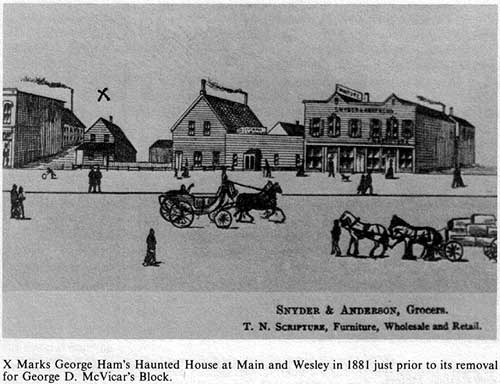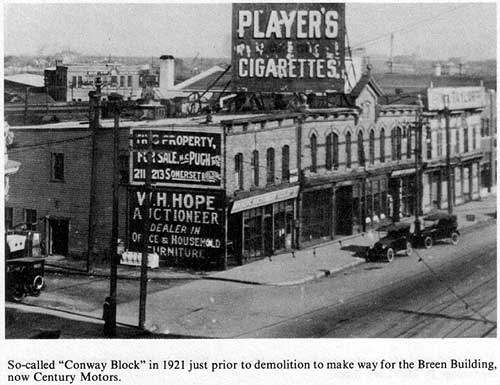Manitoba Pageant, Autumn 1977, Volume 23, Number 1
|
One might think that in a city as young as Winnipeg, that there might not be such a thing as a haunted house or place. There is always the tendency to associate such matters with the old ruined abbeys of England or the mountain-top castles of Europe. However, a century ago, it was discovered that young Winnipeg had a "ghost" of its own, and the eventual solution to the mysterious goings on came almost fifty years later.
George Ham, in his book Reminiscences of a Raconteur related a somewhat jocular account of a haunted house he had inhabited from March, 1877 to November 1880. [1] The house stood immediately to the south of the first Grace Church [2] and somewhat to the north of Snyder and Anderson's wholesale grocery store. [3] The edifice had been probably built and first occupied by Captain George H. Young about 1874 or 1875. [4] Ham was the next tenant and appears to have been a witness to a number of "spectral events," such as a self-rattling stove, self-slamming doors and a self-flooding basement, that upon investigation, did not remain flooded. [5] However, as there was no real damage done, Ham decided to "live and let live" remaining there until November, 1880. At that time, Captain Young let the house to a cigar manufacturer named Conlisk. This latter person lasted about a month before the "visitations" became too odious. [6]
Early in 1881, Young sold a portion of his Main Street frontage to George D. McVicar, a prominent Winnipeg citizen. The great land boom was already underway and thus, McVicar undertook to move the relatively new house to a location in the "north-end" of the city. [7] While on its way to the new site the building gave its movers some problems, as it "deranged" numerous telephone wires. [8] Once there, however, it appears not to have given its occupants any further trouble and settled down to become a "normal" house. [9] On the Main Street site, McVicar erected a two storey frame block of two stores which cost $3,000. [10] The New York Piano Company under the management of one Mr. Prince was the first tenant in the McVicar Block. [11]
The scene now shifts from Winnipeg during the "crazy eighties" to that of Winnipeg in the "roaring twenties." The area to the south of Wesley Avenue on the east side of Main contained some of the oldest and most decrepit buildings in the city. Among these was the McVicar Block, subsequently renamed the Conway Block (for Michael Conway, a noted auctioneer) and latterly the Clinton Block. Since 1882, the number of this building had been 257-59 Main Street. During 1922, the Breen Motor Company purchased the two old tumble-down structures known as the Conway Block [12] and demolished the pair. While excavating for the foundations of the large three storey reinforced concrete edifice, a Slavic labourer made a gruesome discovery - four human skeletons. [13] The Provincial Coroner Dr. O'Connell took charge of the matter from that point and nothing further was heard on the topic.

The grisly find was not without its revelations. Old timers emerged from retirement with a tale that seemed to make some sense. It would appear that after Ham's former house was removed from the site, the spectral visitor continued the haunting in the McVicar Block. For many years, it had been reported to be very noisy at times and the exhumation of the skeletons only confirmed the old stories. [14] Furthermore, the remains had been found beneath the second store from the north end of the old Conway Block, a site that corresponded to the location of Ham's residence.

The Main Street skeletons were probably the last Indian remains to be unearthed in the present downtown. [15] Over a period of twenty years, 1876-1897, a plethora of human remains emerged from the ground as the city was being built. There is substantial evidence that an Indian burial ground existed in the area bounded by Water and Main to the north and St. Mary's and Fort Street to the south and west. This was formerly a portion of the Hudson's Bay Reserve. From the existing evidence, there is an indication that the remains as found were probably an archeological treasure-trove of a past civilization, and probably could have been interpreted had the discoverers realized the importance of what they had found. Instead, the skulls and trinkets were carried off as souvenirs by passers-by and small boys, for Indian graves were not considered to be sacred to anyone save the "heathen savage."
According to one 1876 account, an old resident stated that burials had taken place in the area as late as 1851. [16] Furthermore, the area seems to have been centered in the space now falling between Water and Wesley Streets. [17] Ham acknowledged this location by citing "tradition" in his book. [18] While the western portion of this burying ground has been built and rebuilt upon with substantial structures, the section known as the East Yards has remained virtually untouched, save for the construction of rail lines since the 1890s. While the Indians had abandoned their burial ground with its shallow graves at the time of the beginnings of the village of Winnipeg, the area known as the "Flats" (now the "Yards") was known as a rather out of the way and disreputable part of the city. This reputation probably stemmed from the latent memory of a cemetery being there, and the area developed accordingly.
While the "haunting" of Ham's house and of the McVicar Block can probably be dismissed as a good ghost story, there still remains the possibility of a potentially rich archeological area east of Main Street. With the pending development of the East Yards, the last traces of that burying ground will be erased forever. Large machines will unsympathetically plow up and excavate the area, thereby making an archeological "dig" an impossibility in such a potentially rich area. Possibly the burying ground stopped just east of Main, for the "Flats" were very prone to flooding as a low-lying area. The potentiality of the site could be enormous. And, of course, there is the question: shall we allow human remains to be trodden underfoot just as our counterparts of a century ago did, because the Indian was considered less than human? Lastly, on a lighter note, it might be interesting to find out if the "spectral visitations" continued after the erection of the Breen Building in 1922 and if a "rattling" and "slamming" commentary is annually made at the time of the model changes!
Special thanks to Mr. W. G. Speechly for his help with and suggestions for this article.
1. George H. Ham Reminiscences of a Raconteur (Toronto: Musson, 1921) pp. 138-141. Hereafter cited as Ham. In a newspaper article in the Weekly Free Press, 15 December 1882 entitled "Canadian Ghosts," reference is made to a "prominent citizen" (George Ham) living there from March 1876, a year earlier than the 1921 account. Directory information has been unable to clarify the difference.
2. Erected by Reverend George Young in 1871 on the present site of the parking lot adjoining the Federal Building.
3. Constructed during 1873 and probably demolished in the mid-1920s.
4. Photographic evidence would indicate that the house was not yet in existence during 1872, while a newspaper account published late in 1873 does not list the small, storey and a half edifice. Therefore, given Ham's two dates, 1876 or 1877, one must assume that Young built the house during 1874 or 1875.
6. "Canadian Ghosts," Manitoba Weekly Free Press, 15 December 1882. Hereinafter, cited as Ghosts.
7. This may have been the corner of Pacific and King Street.
8. Manitoba Free Press, 16 June 1881, p. 1.
9. Ham, op. cit., p. 140; also Ghosts, loc. cit. The building, if moved to Pacific and King was probably demolished about 1910.
10. "City Progress," Winnipeg Sun, 17 October 1881, p. 1. The front was probably brick-veneered a short time later, though - old photographs indicate that the sides were left without brick. This was a common practice at the time and was a way to circumvent the fire limits by-law of the era.
11. Henderson's City of Winnipeg Directory for 1882.
12. Captain Young had erected a larger block of stores to the south of McVicar's Block in 1881. According to old pictures, the two were quite dilapidated by the early 1920s. Breen's is now called Century Motors.
13. "Skeleton Found 'Neath Floor Conway Block," MFP, 1 September 1922, p. 17. Also, see "Proves Existence of Indian Cemetery," Tribune, 11 September 1922, p. 5.
15. When found, the first skeleton was stated to be a "white man" though it was subsequently proven an Indian.
16. MFP, 2 November 1876, p. 3. The occasion was the finding of a skeleton on Main Street just south of the Union House at the north-west corner of St. Mary and Main. An effort had been made to secure the skull for the Smithsonian but finder declined to part with his discovery.
17. MFP, 15 May 1876, p. 3. This account mentions an old Indian burial ground to the rear of Grace Church which was being built on with results that delighted human bone collectors of the age. Also, see MFP, 25 June 1889, p. 4 and 28 June 1889, p. 4 for notes of remains found while excavating for the basement of the ill-fated Manitoba Hotel.
18. Ham, op. cit. p. 138. In Ghosts, the account stated that it was believed the house was built on the graves of three young Indian women. As stated, "if they kicked up the racket [they] ought to be ashamed of themselves. No respectable corpse would act so outrageously right next door to a church."
Page revised: 27 October 2010